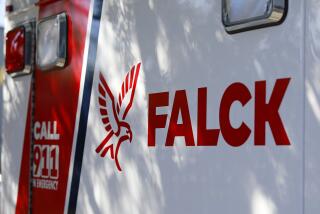CareLine Will Buy LifeFleet in Ambulance Service Merger : Acquisition: The Irvine firm will pay $93 million in the deal, which would make it the nation’s second-largest provider.
- Share via
IRVINE — In a deal that would make it the nation’s second-largest provider of ambulance service, CareLine Inc. said Thursday that it will acquire privately held LifeFleet Inc. for $93 million in cash.
The transaction, expected to be completed by the end of May, is the largest deal in a rapidly consolidating industry that only a few years ago was composed of more than 2,600 mom-and-pop operations.
The merged company will have 2,800 drivers, paramedics, dispatchers and administrators in eight states. With projected annual revenue of more than $160 million, it will be second only to American Medical Response in Boston.
Ambulance service generates $4 billion a year in revenue nationally, and the country’s aging population assures continued growth in the industry, said Nancy Moyer, an industry analyst at Unterberg Harris, a New York brokerage.
The emergence of large publicly held ambulance companies began only two years ago with the formation of American Medical. The company was created by the merger of four companies, including two in Northern California.
The financial incentive appears great. Two years ago, Moyer said, the average basic non-emergency trip cost $400 and life-support trips were $700. Critical-care transport, in rigs that look like mini-intensive-care units, ran about $1,500 a trip.
Those charges helped to make up for the 20% to 40% of bills that went unpaid, she said. And the expense of putting in state-of-the-art medical and communications equipment as well as meeting stricter regulations that require quick responses has become a financial burden for small companies. In addition, only larger operations can expect to obtain sufficient funding from Wall Street.
“There are still significant opportunities to grow,” said Thomas E. Sullivan, an analyst with Minneapolis brokerage Piper, Jaffray Inc. “We’ve only consolidated a fraction of the companies.”
CareLine, he said, made a number of acquisitions before and after it went public in December with a stock offering that gave it $52.2 million. And it has access to more money, he said.
Next week, the company will start issuing debt securities--essentially corporate IOUs--to raise $75 million, said Roy Luna, CareLine’s chief financial officer. The proceeds, together with bank loans, will pay for the acquisition of Newport Beach-based LifeFleet and other companies CareLine hopes to buy in the near future, he said.
The acquisition would strengthen CareLine’s presence in Southern California.
LifeFleet has operations in Anaheim; Seattle, Spokane and Tacoma, Wash., and six sites in central and southern Florida. CareLine operates in Los Angeles, San Bernardino and Riverside counties, Boston, Atlanta, as well as Birmingham, Ala.; Pueblo, Colo., and southeastern Tennessee. It also has two acquisitions pending in Philadelphia and one in Wichita Falls, Tex.
LifeFleet is owned by Secom Co. Ltd., a Tokyo residential and commercial security company that also owns Westec Security.
Combined Forces: The CareLine-LifeFleet Merger
Two Orange County-based ambulance companies will merge to form the nation’s second-largest emergency medical services firm. Details on Irvine-based CareLine’s acquisition of LifeFleet, its Newport Beach-based competitor:
CARELINE AT A GLANCE
Founded: 1992 Headquarters: Irvine President and CEO: Keith Huzyak Employees: 1,200 Service area: Parts of California, Colorado, Alabama, Georgia, Massachusetts, Tennessee 1993 revenue: $32 million
LIFEFLEET AT A GLANCE
Founded: 1988 Headquarters: Newport Beach President and CEO: George DeHuff Employees: 1,600 Service area: Parts of Washington, Florida and California 1993 revenue: $82 million Acquisition price: $93 million
CARELINE AFTER THE MERGER
President and CEO: Keith Huzyak Employees: About 2,800 Transports per year: 750,000 Service area: The firms’ combined service areas, as well as Philadelphia and Wichita Falls, Tex., where CareLine has letters of intent to acquire additional firms. Revenue breakdown: 60% from emergency care and transport; 40% from inter-facility transportation
Source: CareLine Inc.; Researched by JANICE L. JONES / Los Angeles Times
More to Read
Inside the business of entertainment
The Wide Shot brings you news, analysis and insights on everything from streaming wars to production — and what it all means for the future.
You may occasionally receive promotional content from the Los Angeles Times.










